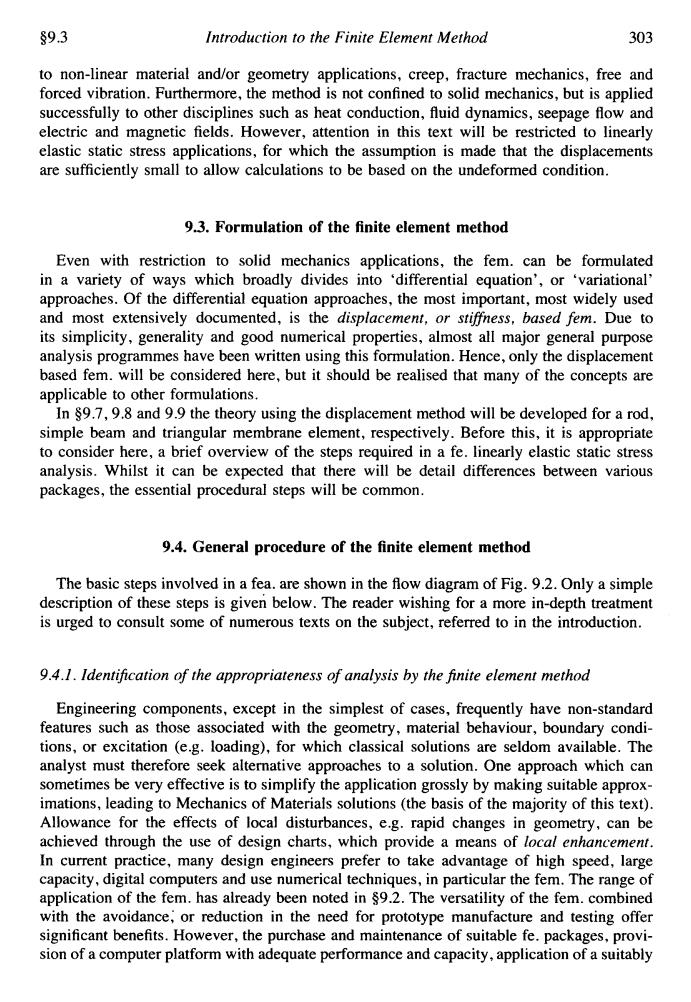正在加载图片...

§9.3 Introduction to the Finite Element Method 303 to non-linear material and/or geometry applications,creep,fracture mechanics,free and forced vibration.Furthermore,the method is not confined to solid mechanics,but is applied successfully to other disciplines such as heat conduction,fluid dynamics,seepage flow and electric and magnetic fields.However,attention in this text will be restricted to linearly elastic static stress applications,for which the assumption is made that the displacements are sufficiently small to allow calculations to be based on the undeformed condition. 9.3.Formulation of the finite element method Even with restriction to solid mechanics applications,the fem.can be formulated in a variety of ways which broadly divides into 'differential equation',or 'variational' approaches.Of the differential equation approaches,the most important,most widely used and most extensively documented,is the displacement,or stiffness,based fem.Due to its simplicity,generality and good numerical properties,almost all major general purpose analysis programmes have been written using this formulation.Hence,only the displacement based fem.will be considered here,but it should be realised that many of the concepts are applicable to other formulations. In $9.7,9.8 and 9.9 the theory using the displacement method will be developed for a rod, simple beam and triangular membrane element,respectively.Before this,it is appropriate to consider here,a brief overview of the steps required in a fe.linearly elastic static stress analysis.Whilst it can be expected that there will be detail differences between various packages,the essential procedural steps will be common. 9.4.General procedure of the finite element method The basic steps involved in a fea.are shown in the flow diagram of Fig.9.2.Only a simple description of these steps is given below.The reader wishing for a more in-depth treatment is urged to consult some of numerous texts on the subject,referred to in the introduction. 9.4.1.Identification of the appropriateness of analysis by the finite element method Engineering components,except in the simplest of cases,frequently have non-standard features such as those associated with the geometry,material behaviour,boundary condi- tions,or excitation (e.g.loading),for which classical solutions are seldom available.The analyst must therefore seek alternative approaches to a solution.One approach which can sometimes be very effective is to simplify the application grossly by making suitable approx- imations,leading to Mechanics of Materials solutions(the basis of the majority of this text). Allowance for the effects of local disturbances,e.g.rapid changes in geometry,can be achieved through the use of design charts,which provide a means of local enhancement. In current practice,many design engineers prefer to take advantage of high speed,large capacity,digital computers and use numerical techniques,in particular the fem.The range of application of the fem.has already been noted in $9.2.The versatility of the fem.combined with the avoidance;or reduction in the need for prototype manufacture and testing offer significant benefits.However,the purchase and maintenance of suitable fe.packages,provi- sion of a computer platform with adequate performance and capacity,application of a suitably$9.3 Introduction to the Finite Element Method 303 to non-linear material and/or geometry applications, creep, fracture mechanics, free and forced vibration. Furthermore, the method is not confined to solid mechanics, but is applied successfully to other disciplines such as heat conduction, fluid dynamics, seepage flow and electric and magnetic fields. However, attention in this text will be restricted to linearly elastic static stress applications, for which the assumption is made that the displacements are sufficiently small to allow calculations to be based on the undeformed condition. 93. Formulation of the finite element method Even with restriction to solid mechanics applications, the fem. can be formulated in a variety of ways which broadly divides into ‘differential equation’, or ‘variational’ approaches. Of the differential equation approaches, the most important, most widely used and most extensively documented, is the displacement, or stiffness, based fem. Due to its simplicity, generality and good numerical properties, almost all major general purpose analysis programmes have been written using this formulation. Hence, only the displacement based fem. will be considered here, but it should be realised that many of the concepts are applicable to other formulations. In 99.7,9.8 and 9.9 the theory using the displacement method will be developed for a rod, simple beam and triangular membrane element, respectively. Before this, it is appropriate to consider here, a brief overview of the steps required in a fe. linearly elastic static stress analysis. Whilst it can be expected that there will be detail differences between various packages, the essential procedural steps will be common. 9.4. General procedure of the finite element method The basic steps involved in a fea. are shown in the flow diagram of Fig. 9.2. Only a simple description of these steps is given below. The reader wishing for a more in-depth treatment is urged to consult some of numerous texts on the subject, referred to in the introduction. 9.4.1. Identification of the appropriateness of analysis by the finite element method Engineering components, except in the simplest of cases, frequently have non-standard features such as those associated with the geometry, material behaviour, boundary conditions, or excitation (e.g. loading), for which classical solutions are seldom available. The analyst must therefore seek alternative approaches to a solution. One approach which can sometimes be very effective is to simplify the application grossly by making suitable approximations, leading to Mechanics of Materials solutions (the basis of the majority of this text). Allowance for the effects of local disturbances, e.g. rapid changes in geometry, can be achieved through the use of design charts, which provide a means of local enhancement. In current practice, many design engineers prefer to take advantage of high speed, large capacity, digital computers and use numerical techniques, in particular the fem. The range of application of the fern. has already been noted in 09.2. The versatility of the fem. combined with the avoidance; or reduction in the need for prototype manufacture and testing offer significant benefits. However, the purchase and maintenance of suitable fe. packages, provision of a computer platform with adequate performance and capacity, application of a suitably